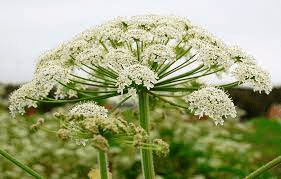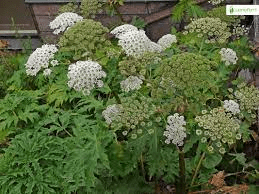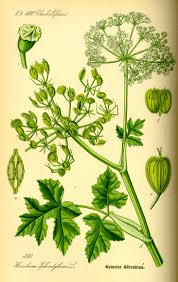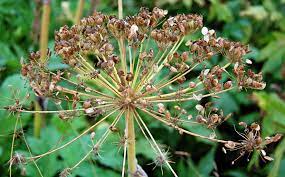Heracleum persicum, commonly known as Persian Hogweed, is a plant species belonging to the Apiaceae family. Native to the Middle East and Central Asia, it is characterized by its robust, herbaceous growth, reaching heights of up to 2 meters. The plant features large, compound leaves and produces umbrella-shaped clusters of small white flowers.
One of the notable aspects of Heracleum persicum is its traditional medicinal uses in various cultures. Different parts of the plant, such as roots, leaves, and seeds, have been employed in folk medicine for their potential therapeutic properties. Some traditional uses include the treatment of digestive issues, respiratory problems, and skin conditions.
However, it’s essential to note that Heracleum persicum contains certain chemical compounds, such as furanocoumarins, which can make the plant phototoxic.
Contact with the sap of the plant, followed by exposure to sunlight, may lead to skin irritation and blistering in some individuals. Due to these potential adverse effects, caution is advised when handling Persian Hogweed.
In recent years, scientific research has also focused on exploring the phytochemical composition of Heracleum persicum and its possible pharmacological activities. Further studies are needed to better understand the plant’s medicinal properties and potential applications in modern medicine.
As with many traditional remedies, it is important to approach the use of Heracleum persicum with a balanced perspective, considering both its historical significance and potential risks.
The Botanical Description of Heracleum persicum
1. Size and Structure: Heracleum persicum, commonly known as Persian hogweed, is a robust, perennial herbaceous plant. It typically reaches a height of 2 to 3 meters, featuring a sturdy and erect stem.
2. Leaves: The plant’s leaves are compound, deeply lobed, and can span up to 1 meter in width. They exhibit a distinctive serrated margin and are arranged alternately along the stem.
3. Flowers: Persian hogweed produces large umbels of tiny white flowers, forming a conspicuous inflorescence. The inflorescence can measure up to 50 centimeters in diameter and attracts pollinators with its aromatic scent.
4. Stem: The stem of Heracleum persicum is stout, hollow, and grooved. It bears fine hairs and may have purple spots, adding to its distinctive appearance.
5. Root System: The plant has a well-developed taproot system, allowing it to thrive in various soil conditions. The roots are essential for nutrient absorption and overall stability.
6. Fruits: The fruits of Heracleum persicum are small, elliptical, and possess prominent ridges. These fruits are commonly referred to as schizocarps and contain seeds that aid in the plant’s reproduction.
7. Habitat: Persian hogweed is adaptable and can be found in diverse habitats, including meadows, riverbanks, and forest clearings. It is well-suited to temperate climates.
8. Growth Cycle: Heracleum persicum follows a seasonal growth cycle, with seeds germinating in the spring and the plant reaching maturity in the summer. After flowering, the plant produces seeds for the next generation.
9. Leaflet Characteristics: Each leaflet of Heracleum persicum is lance-shaped, creating a visually striking foliage. The serrated edges serve as a natural deterrent against herbivores.
10. Reproductive Features: The plant relies on both sexual and asexual reproduction methods. While seeds are the primary means of sexual reproduction, Persian hogweed can also propagate through root sprouts.
11. Ecological Interactions: Heracleum persicum plays a role in supporting biodiversity by providing habitat and food for various insects and small animals. It contributes to the ecological balance of its native regions.
12. Phenological Traits: Persian hogweed exhibits distinct phenological stages, including bud development, flowering, seed formation, and dormancy during the winter months. Understanding these stages is crucial for effective cultivation and management.
The Geographic Distribution of Heracleum persicum

1. Native Range: Heracleum persicum is native to the Caucasus region, spanning countries like Iran, Azerbaijan, and Armenia. It thrives in the diverse ecosystems of this region.
2. Eurasian Presence: Beyond its native range, Persian hogweed has established populations in various Eurasian countries, including Turkey, Russia, and Georgia. It demonstrates adaptability to different climates.
3. Altitudinal Range: This plant is known to grow at a wide range of altitudes, from lowlands to mountainous regions. It can be found at elevations ranging from sea level to over 2,000 meters.
4. Invasive Characteristics: In some areas, Heracleum persicum has exhibited invasive tendencies, outcompeting native vegetation. This invasive behavior has raised concerns among environmental conservationists.
5. Human-Mediated Spread: The plant’s seeds can be dispersed through human activities, such as transportation of contaminated soil or agricultural equipment. This has contributed to its presence in non-native regions.
6. Soil Preferences: Persian hogweed shows adaptability to various soil types, but it thrives in well-drained soils with moderate fertility. It can be found in meadows, along riverbanks, and in disturbed areas.
7. Climate Adaptation: The plant is well-adapted to temperate climates, with a preference for regions with distinct seasons. It can withstand cold winters and hot summers, showcasing its resilience.
8. Biotic Associations: Heracleum persicum interacts with a range of biotic factors, forming ecological relationships with pollinators, herbivores, and soil microorganisms. These interactions contribute to its ecological role.
9. Conservation Status: Due to its invasive nature in certain regions, efforts are underway to monitor and manage populations of Heracleum persicum. Conservation strategies aim to balance its ecological impact.
10. Global Distribution: Beyond its original range, Persian hogweed has been introduced to parts of Europe and North America, where it has become naturalized. Understanding its distribution aids in effective management.
11. Impact on Local Flora: In areas where Heracleum persicum has become invasive, it can outcompete and displace native plant species. This impact on local flora underscores the importance of monitoring and control measures.
The Chemical Composition of Heracleum persicum
1. Essential Oils: Heracleum persicum contains essential oils, including compounds such as limonene, phellandrene, and pinene. These oils contribute to the plant’s aromatic properties.
2. Furanocoumarins: Persian hogweed is known for its content of furanocoumarins, including psoralen and bergapten. These compounds play a role in the plant’s defense mechanisms and have potential medicinal applications.
3. Flavonoids: The plant synthesizes flavonoids, which are known for their antioxidant properties. Quercetin and kaempferol are examples of flavonoids present in Heracleum persicum.
4. Phenolic Compounds: Phenolic compounds, such as caffeic acid and chlorogenic acid, are found in the plant. These compounds contribute to the antioxidant and anti-inflammatory potential of Persian hogweed.
5. Polyacetylenes: Heracleum persicum is rich in polyacetylenes, including falcarinol and falcarindiol. These compounds exhibit antimicrobial properties and are under investigation for their potential health benefits.
6. Terpenoids: The presence of terpenoids, including sesquiterpenes, adds to the chemical diversity of Heracleum persicum. These compounds contribute to the plant’s ecological interactions.
7. Alkaloids: While present in smaller quantities, alkaloids such as gamma-terpinene have been identified in Persian hogweed. The role of alkaloids in the plant’s overall chemical profile is an area of ongoing research.
8. Carotenoids: Heracleum persicum contains carotenoids, which contribute to the plant’s coloration. Carotenoids also have antioxidant properties that benefit both the plant and potential consumers.
9. Tannins: Tannins are present in the plant and are associated with astringent properties. Their role in defense against herbivores and potential medicinal applications are subjects of scientific inquiry.
10. Sterols: Heracleum persicum accumulates trace elements from the soil, and their presence can vary depending on the plant’s geographic location. Monitoring trace elements is important for both ecological and human health considerations.
11. Proteins and Enzymes: The plant synthesizes proteins and enzymes that play essential roles in its metabolic processes. Understanding these biochemical components adds depth to the knowledge of Heracleum persicum.
12. Trace Elements: Heracleum persicum accumulates trace elements from the soil, and their presence can vary depending on the plant’s geographic location. Monitoring trace elements is important for both ecological and human health considerations.
13. Aromatic Compounds: Aromatic compounds contribute to the distinct scent of Heracleum persicum. These compounds may have ecological roles, such as attracting pollinators and deterring herbivores.
14. Organic Acids: The plant contains organic acids, including citric acid and malic acid. These acids contribute to the overall acidity of the plant and may have implications for its physiological processes.
Read Also: 8 Medicinal Health Benefits of Populus Grandidentata (Bigtooth Aspen)
The Medicinal Health Benefits Of Heracleum persicum (Persian Hogweed)

1. Anti-Inflammatory Properties: Heracleum persicum has demonstrated anti-inflammatory effects, attributed to compounds like furanocoumarins and flavonoids. These properties may be beneficial for conditions involving inflammation.
2. Antioxidant Activity: The plant’s rich content of flavonoids, carotenoids, and phenolic compounds contributes to its antioxidant potential. Antioxidants help neutralize free radicals in the body, supporting overall health.
3. Digestive Health: Persian hogweed has been traditionally used to address digestive issues. Compounds like polyacetylenes may contribute to its digestive benefits, promoting a healthy gut.
4. Respiratory Support: Some studies suggest that Heracleum persicum may have respiratory benefits, potentially alleviating symptoms associated with respiratory conditions. Further research is ongoing in this area.
5. Immune System Modulation: The plant’s bioactive compounds, including essential oils, may play a role in modulating the immune system. This modulation could enhance the body’s ability to defend against infections.
6. Skin Conditions: External applications of Heracleum persicum have been explored for managing certain skin conditions. The anti-inflammatory and antimicrobial properties may contribute to its effectiveness.
7. Pain Relief: Traditional uses of Persian hogweed include pain relief, with compounds like furanocoumarins possibly influencing pain pathways. However, more research is needed to establish its efficacy.
8. Cardiovascular Health: Some studies suggest that the plant’s antioxidant and anti-inflammatory properties may contribute to cardiovascular health by supporting blood vessel function and reducing oxidative stress.
9. Antimicrobial Activity: Heracleum persicum exhibits antimicrobial properties, attributed to compounds like polyacetylenes. This antimicrobial activity may be beneficial for addressing various infections.
10. Anti-Cancer Potential: Preliminary studies indicate that certain compounds found in Persian hogweed may have anti-cancer properties. However, extensive research is required to understand the mechanisms and potential applications.
11. Anti-Diabetic Effects: Compounds in Heracleum persicum, such as flavonoids and polyacetylenes, have been investigated for their potential anti-diabetic effects. These compounds may influence glucose metabolism.
12. Stress Management: The plant’s adaptogenic properties have led to investigations into its potential role in stress management. Compounds like terpenoids may contribute to the plant’s adaptogenic effects.
13. Wound Healing: External applications of Heracleum persicum have been traditionally used for wound healing. The plant’s antimicrobial and anti-inflammatory properties may support the healing process.
14. Menstrual Health: Traditional uses of Persian hogweed include addressing menstrual irregularities. Its potential hormonal effects may influence menstrual health, but more research is needed in this area.
15. Cognitive Function: Some compounds present in Heracleum persicum, such as flavonoids, have been studied for their potential effects on cognitive function. These neuroprotective properties are of interest for brain health.
16. Liver Support: Preliminary research suggests that certain compounds in Persian hogweed may have hepatoprotective effects, supporting liver health and function.
17. Anti-allergic Properties: Compounds like quercetin in Heracleum persicum contribute to its anti-allergic potential. This may be beneficial for individuals dealing with allergic reactions.
18. Bone Health: The plant’s nutritional components, including trace elements, may have implications for bone health. Further studies are needed to explore its role in supporting skeletal well-being.
19. Anti-Aging Effects: The antioxidant-rich profile of Heracleum persicum may contribute to its anti-aging effects by combating oxidative stress, supporting skin health, and promoting overall vitality.
The Methods of Usage to Achieve the Provided Health Benefits Of Heracleum persicum (Persian Hogweed)
1. Herbal Infusions: Prepare herbal infusions using dried Heracleum persicum leaves to harness its medicinal properties. This method is suitable for addressing digestive issues and promoting overall well-being.
2. Topical Applications: For skin-related benefits, create topical applications by crushing fresh leaves or using essential oils derived from Persian hogweed. Apply to affected areas for potential anti-inflammatory and antimicrobial effects.
3. Culinary Use: Incorporate Heracleum persicum leaves into culinary creations. This can be done by adding the leaves to salads, soups, or other dishes, providing a flavorful and health-promoting addition to meals.
4. Tinctures: Tinctures can be prepared using Heracleum persicum roots or leaves. This method is convenient for those seeking a concentrated form of the plant’s bioactive compounds.
5. Steam Inhalation: Harness the respiratory benefits of Persian hogweed by using steam inhalation. Add dried leaves or essential oil to hot water and inhale the steam to potentially alleviate respiratory symptoms.
6. Poultices: Create poultices by mashing fresh leaves and applying them to wounds or skin irritations. This method utilizes the plant’s antimicrobial and anti-inflammatory properties for localized benefits.
7. Herbal Teas: Brew herbal teas using Heracleum persicum leaves for a soothing and health-promoting beverage. This is an enjoyable way to incorporate the plant into daily routines.
8. Capsule Supplements: For those who prefer a convenient option, Heracleum persicum supplements in capsule form are available. This allows for controlled and standardized intake of the plant’s beneficial compounds.
9. Infused Oils: Prepare infused oils by steeping Heracleum persicum leaves or roots in carrier oils. This can be applied topically for skin-related benefits or used in massage for potential anti-inflammatory effects.
10. Dietary Supplement: Integrate Heracleum persicum into the diet through dietary supplements. This method ensures a consistent and measured intake of the plant’s medicinal components.
11. Aromatic Potpourri: Utilize the aromatic compounds of Persian hogweed by creating potpourri. Dried leaves can be added to mixtures for a fragrant and potentially mood-enhancing home accessory.
12. Herbal Baths: Add Heracleum persicum leaves or extracts to baths for a relaxing and aromatic experience. This method may contribute to skin health and provide a sense of well-being.
The Side Effects Of Using Heracleum persicum Medicinal Plant
1. Photosensitivity: Heracleum persicum contains furanocoumarins, which may cause photosensitivity. Individuals using topical applications should exercise caution when exposed to sunlight.
2. Allergic Reactions: Some individuals may experience allergic reactions to compounds present in Persian hogweed. It is advisable to perform a patch test before extensive use, especially for topical applications.
3. Gastrointestinal Discomfort: In some cases, the consumption of Heracleum persicum may lead to gastrointestinal discomfort, including nausea or stomach upset. Moderation is key to avoid adverse effects.
4. Interaction with Medications: Individuals taking medications, especially those with photosensitizing or anticoagulant effects, should consult a healthcare professional before using products containing Heracleum persicum.
5. Skin Irritation: Direct contact with the plant’s sap or essential oils may cause skin irritation in sensitive individuals. It’s important to dilute and perform a patch test before applying to larger areas.
6. Pregnancy and Lactation: Pregnant and lactating individuals should exercise caution, as the safety of Heracleum persicum during these periods has not been thoroughly studied. Consultation with a healthcare provider is advised.
7. Blood Pressure Concerns: Compounds in Persian hogweed may have effects on blood pressure. Individuals with hypertension should monitor their blood pressure closely if considering the use of Heracleum persicum.
8. Avoidance for Certain Health Conditions: Individuals with liver conditions, hormonal disorders, or those undergoing surgery should avoid Heracleum persicum due to potential interactions and effects on these health conditions.
9. Long-term Use Caution: Prolonged or excessive use of Heracleum persicum supplements may lead to unforeseen health effects. It’s advisable to use the plant in moderation and under professional guidance.
10. Children and Elderly: Special caution should be exercised when considering the use of Heracleum persicum in children or elderly individuals. Consulting with a healthcare professional is recommended.
11. Respiratory Sensitivity: Individuals with respiratory conditions should be cautious with the inhalation of Heracleum persicum steam, as it may trigger respiratory sensitivity in some cases.
12. Impact on Beneficial Insects: The plant’s invasive nature in certain regions may negatively impact local ecosystems and beneficial insects. Awareness of ecological consequences is essential.
Read Also: 19 Medicinal Health Benefits Of Lotus (Nelumbo nucifera)
The Scientific Research and Studies of Heracleum persicum

1. Anti-Inflammatory Properties: Scientific studies have investigated the anti-inflammatory effects of Heracleum persicum, focusing on the role of furanocoumarins and flavonoids in mitigating inflammation.
2. Antioxidant Activity: Research has explored the antioxidant potential of Heracleum persicum, highlighting the contribution of flavonoids, carotenoids, and phenolic compounds in scavenging free radicals.
3. Respiratory Benefits: Preliminary studies suggest that Persian hogweed may have positive effects on respiratory health, potentially providing relief for individuals with respiratory conditions. However, more extensive research is needed.
4. Immunomodulatory Effects: The plant’s bioactive compounds, particularly essential oils, have been studied for their immunomodulatory effects. This research aims to understand how Heracleum persicum may enhance immune system function.
5. Anti-Cancer Properties: Some scientific studies have explored the anti-cancer potential of compounds found in Persian hogweed. However, these findings are in the early stages, and further research is crucial for validation.
6. Anti-Diabetic Effects: Investigations into the potential anti-diabetic effects of Heracleum persicum compounds, including flavonoids and polyacetylenes, are ongoing. Understanding their impact on glucose metabolism is essential.
7. Neuroprotective Properties: Scientific research has delved into the neuroprotective properties of certain compounds present in Heracleum persicum, particularly flavonoids. These studies aim to elucidate their effects on cognitive function.
The Safety Precautions and Recommendations In Using Heracleum persicum Medicinal Plant
1. Consultation with Healthcare Professionals: Before incorporating Heracleum persicum into any health regimen, individuals should consult with healthcare professionals, especially if they have pre-existing health conditions or are taking medications.
2. Patch Test for Topical Applications: Perform a patch test before applying Heracleum persicum topically to check for any allergic reactions or skin sensitivities. Dilute essential oils appropriately to minimize the risk of irritation.
3. Sun Protection Measures: Due to potential photosensitivity, individuals using topical applications of Heracleum persicum should take adequate sun protection measures, such as using sunscreen and protective clothing.
4. Moderation in Consumption: Consume Heracleum persicum in moderation, especially when using it as a dietary supplement or herbal infusion. Excessive intake may lead to adverse effects, and a balanced approach is recommended.
5. Monitoring Blood Pressure: Individuals with hypertension or cardiovascular concerns should closely monitor their blood pressure when considering the use of Heracleum persicum due to its potential effects on blood pressure.
6. Pregnancy and Lactation Caution: Pregnant and lactating individuals should exercise caution, as the safety of Heracleum persicum during these periods is not well-established. Consultation with healthcare providers is advised.
7. Avoidance in Liver Conditions: Individuals with liver conditions should avoid the use of Heracleum persicum due to potential interactions and effects on liver health. Professional medical advice is crucial in such cases.
8. Short-Term Use for Respiratory Sensitivity: Individuals with respiratory conditions should consider short-term use of Heracleum persicum for respiratory benefits, closely monitoring for any sensitivity or adverse reactions.
9. Ecological Awareness: When cultivating or using Heracleum persicum, individuals should be aware of its ecological impact, especially in regions where it may exhibit invasive behavior. Responsible cultivation practices are encouraged.
10. Discontinue in Case of Adverse Effects: If individuals experience any adverse effects or unexpected reactions to Heracleum persicum, they should discontinue use and seek medical advice promptly.
11. Caution in Children and Elderly: Special attention should be given to the use of Heracleum persicum in children and elderly individuals. Dosages and applications should be adjusted based on individual health considerations.
12. Environmental Considerations: Individuals cultivating Heracleum persicum should be mindful of its potential impact on the local environment, considering its invasive tendencies in certain regions.
13. Sustainable Harvesting Practices: If harvesting Heracleum persicum from the wild, individuals should adopt sustainable practices to ensure the long-term viability of plant populations and minimize ecological disruption.
14. Adherence to Local Regulations: Individuals should adhere to local regulations and guidelines regarding the cultivation, harvesting, and use of Heracleum persicum. This includes being aware of any restrictions on the collection or cultivation of the plant in specific regions to support conservation efforts.
15. Research and Education: Before using Heracleum persicum, individuals should invest time in researching its properties and potential interactions. Education on proper usage and dosage is essential to ensure safe and effective utilization.
FAQs About Heracleum persicum Medicinal Plant
1. Can Heracleum persicum be consumed as a food supplement?
Yes, Heracleum persicum can be consumed as a food supplement. The plant’s leaves, roots, and seeds are used in various culinary applications, providing not only flavor but also potential health benefits.
2. Is Heracleum persicum safe for pregnant women?
Pregnant women should exercise caution when considering the use of Heracleum persicum. It’s advisable to consult with a healthcare professional before incorporating the plant into their routine due to limited research on its safety during pregnancy.
3. Are there any known drug interactions with Heracleum persicum?
Individuals taking medications, especially those with photosensitizing or anticoagulant effects, should consult a healthcare professional before using products containing Heracleum persicum. The potential for interactions should be carefully considered.
4. Can Heracleum persicum be used for children’s health?
While Heracleum persicum has been traditionally used, caution should be exercised in children. Dosages and applications should be adjusted based on individual health considerations, and consultation with a healthcare professional is recommended.
5. What are the potential environmental concerns associated with Heracleum persicum?
Heracleum persicum exhibits invasive tendencies in certain regions, which can impact local ecosystems and native flora. Individuals cultivating or using the plant should be aware of its potential environmental consequences and adopt responsible practices.
6. Can Heracleum persicum be grown at home?
Yes, Heracleum persicum can be grown at home, but individuals should be mindful of its growth habits and potential invasiveness. Responsible cultivation practices, such as containment and monitoring, are essential to prevent unintended ecological impacts.
7. How can Heracleum persicum be used topically for skin conditions?
For topical applications, fresh leaves can be crushed or essential oils derived from Heracleum persicum can be used. Applying these to affected areas may harness the plant’s antimicrobial and anti-inflammatory properties for potential skin health benefits.
8. Is there ongoing research on the medicinal properties of Heracleum persicum?
Yes, ongoing scientific research continues to explore the various medicinal properties of Heracleum persicum, including its anti-inflammatory, antioxidant, and potential anti-cancer effects. Researchers aim to further understand its mechanisms and applications.
9. Can individuals with liver conditions use Heracleum persicum?
Individuals with liver conditions should avoid the use of Heracleum persicum due to potential interactions and effects on liver health. Professional medical advice is crucial in such cases to prevent adverse outcomes.
10. What precautions should be taken for individuals with respiratory conditions using Heracleum persicum?
Individuals with respiratory conditions should consider short-term use of Heracleum persicum for potential respiratory benefits. Monitoring for any sensitivity or adverse reactions is essential, and professional medical advice is recommended.
11. How can Heracleum persicum contribute to overall well-being?
Heracleum persicum may contribute to overall well-being through its diverse range of potential health benefits, including anti-inflammatory, antioxidant, and immune-modulating properties. However, individual responses may vary.
12. Can Heracleum persicum be used in aromatherapy?
Yes, the aromatic compounds present in Heracleum persicum make it suitable for use in aromatherapy. Creating potpourri or using dried leaves in aromatic mixtures can provide a fragrant and potentially mood-enhancing experience.
13. Are there any specific recommendations for sustainable harvesting of Heracleum persicum?
Sustainable harvesting of Heracleum persicum involves practices that ensure the long-term viability of plant populations and minimize ecological disruption. This includes harvesting in moderation, avoiding overexploitation, and respecting natural habitats.
14. How can individuals contribute to the conservation of Heracleum persicum?
Contributing to the conservation of Heracleum persicum involves responsible cultivation, adherence to local regulations, and awareness of its potential invasiveness. Supporting initiatives that promote the sustainable use of the plant also aids in conservation efforts.
15. What are the potential economic uses of Heracleum persicum?
Heracleum persicum has economic potential through its various applications, including culinary use, herbal supplements, and potential pharmaceutical developments. Sustainable cultivation practices can contribute to local economies while ensuring ecological responsibility.

